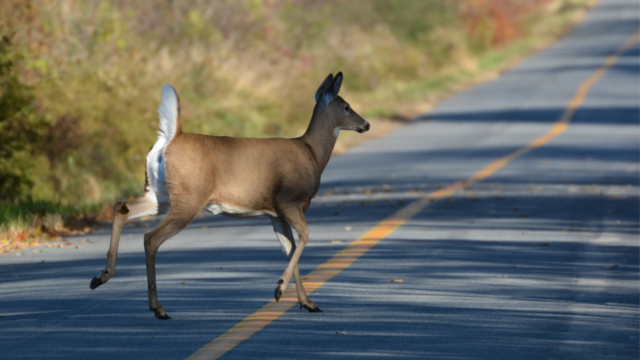

Avoiding a Deer Collision

How can I avoid a deer collision while driving?
If you drive in remote areas where deer or other wildlife are prevalent, it is important to understand your surroundings. Being prepared can help prevent you from adding to the below statistics.
According to the Insurance Information Institute, 1.6 million deer-vehicle collisions occur each year, resulting in 200 fatalities, tens of thousands of injuries, and over $3.6 billion in vehicle damage. If you live in an area with deer or other wildlife or plan to drive in an area prone to these types of collisions, be sure to take these necessary steps to help prevent an accident.
Take a moment to reflect. First, look for road signs. Deer crossing signs picture a deer on a diamond-shaped, yellow sign and are usually placed in high-traffic areas for deer. You may also spot a deer because their eyes brightly reflect car headlights.
Know the area. Be extra cautious on roads surrounded by farmland or trees on either side. Look for posted animal crossing signs, and slow down when you see them. Remember where you have seen wildlife in the past.
Slow down. Always drive the speed limit so you have enough time to scan the road for wildlife and react if an animal crosses your path. Also, remember that your visibility decreases at dawn and dusk, so adjust your vehicle’s speed accordingly.
Public officials frequently attribute deer-vehicle collisions to increasing deer populations while failing to consider the impact of humans on the landscape. We have created more roadways with more people driving on them, disrupted migration routes, and played a major role in the ever-shrinking wildlife habitat.
Additionally, frequent mowing of roadsides (which creates succulent plant growth), along with road-salt use in the winter, attract deer to roads.
If you see one, there are more. Deer are herd animals and frequently travel in single file. If you see one cross the road, chances are there are more waiting. To avoid hitting one, it is better to stop and wait to allow the deer to pass by. Do not “drive around” the deer either. Wait until they cross or run the other way.
Memorize their most active hours. Studies show deer are most active between 5 p.m. to 10 p.m. and 5 a.m. to 8 a.m. During these times, deer are likely to move into open areas that they would normally avoid during daylight hours. On top of that, deer are more active in the fall and winter. Keep that in mind for when you are traveling late in the year.
Do not trust deer horns. They are not proven to work and may startle a deer, causing it to stand still in the roadway.
Do not swerve. If you swerve to avoid an animal, you run the risk of colliding with a guardrail, utility pole or other stationary object. You also might drive off the side of the road and experience a rollover. If you cannot avoid a collision, slow down as much as possible and brace for impact. It is safer than putting your life at risk by swerving.
What should I do if I hit a deer or moose?
If the above plan fails (and it happens to the best drivers), you should take the following steps in the aftermath of a deer collision.
- Pull to the side of the road as soon as it is safe to do so.
- Turn on your hazard lights and remain in the vehicle until you are sure it is safe.
- Call emergency services if injuries are involved or the local police for property damage. Inform the police if the deer is in a dangerous spot on the road.
- Stay away from the deer. If it is still alive, it could be confused, injured and dangerous if approached.
The best defense starts with the you, the driver, constantly scanning along the road. When in doubt, play it safe. Anticipate a visit from these hooved creatures, assuming that they will wander into your path at the worst possible time.


